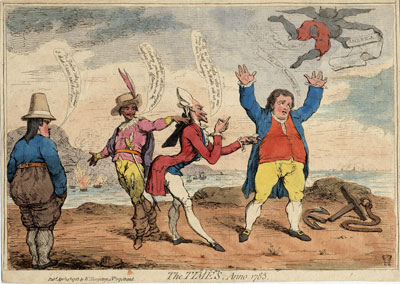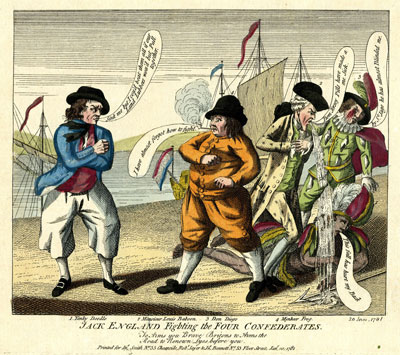The Times, Anno 1783
Using, for the most part, well known visual stereotypes for the countries involved, this print portrays the situation (from left to right) of Holland, Spain, France, Britain, and America in April of 1783.

© Trustees of the British Museum
The biggest news of 1783 was, of course, the conclusion of America's war for independence and the resulting complex negotiations with its allies, each of which sought to gain its own advantage. Preliminary terms of the peace were established in February 1783 (in time for this print), but not finalized until later in the year (September) or, in the case of the Dutch Republic, May of 1784.
But if Gillray knew anything of the real complexity of the situation, he makes little attempt to represent it. All we have are the simplest of attitudes. A demon with a scroll labeled America flies off while farting ironic sympathy: "Poor John Bull! Ha! Ha! Ha!" Britain (through its representative John Bull) expresses his dismay at the flight of America—"Tis lost! Irrecoverably lost." At his feet a broken anchor may suggest the failure of Britain to secure America and prevent its departure. Predictably effete and angular, France offers snuff to John Bull as consolation while gratuitously relieving him of any hope that he might have had—"de Diable will not give you back de Amerique."
The only thing that looks like significant information in the print appears in the figure of Spain who tries to get the attention of France while pointing at a battle raging behind him, saying "See Gibraltar! See Don Langara! by S Anthony you have made me the Laughing Stock of Europe." This is the so-called "Great Siege of Gibralter" a last ditch effort by Spain with help and direction from France to wrest control of Gibralter from the British. The siege was was a spectacular and embarrasing failure and since the siege was lifted most recently on February 9, it was most likely the news that prompted this print.
During the war, the Dutch had divided loyalties: the so-calleds Patriots supporting the French and Americans and the Orangists supporting Britain. With no significant fighting force of their own and relying on the French, the Dutch lost most of her colonies to Britain, prompting the somewhat ungrateful complaint: "De Donder take you Monseiur (sic] I think I have paid the Piper." But in the final treaty, most of those colonies were returned to Holland in order to keep the pro-British Orangists in power.
This print is a good example of the challenges of graphic satire in the 1780s and the transition from a more emblematic design to caricature. Responding to the need to portray an essentially abstract concept such as Spain or France, graphic satirists developed personifications of those countries using a selection of characterics most often associated with them. So France was effete and foppish, Spain was plumed and extravagant, and Holland was stolid and business-like, often with a clay pipe.

Jack England
Fighting the Four Confederates
[January 20, 1781]
© Trustees of the British Museum
In Jack England Fighting the Four Confederates, one can see many of the same visual cues that Gillray uses. The Dutchman is plump and plainly dressed, the Frenchman is thin and bag-wigged, and the Spaniard wears a slashed doublet and breeches. The anonymous designer numbers the figures as in the emblem tradition, but, at the same time gives them, unique names and actions—Jack England, Monsieur Louis Baboon, Mynheer Frog— rather than simply naming them as England, France, and Holland. The effect is to partly individualize them, so that they seem to exist as both symbol and person.
Gillray used national stereotypes on a number of occasions, such as National Discourse (August 9, 1780) and Dutchman in the Dumps (April 9,1781). But in his best work, such as John Bull Triumphant (January 4, 1780), Gillray uses these national stereotypes to create symbolic scenes that accurately reflect national events but with figures sufficiently individualized to be convincing as real people in a real environment.
Sources and Reading
- Commentary from the British Museum on The Times, Anno 1783.
- "1783 in Great Britain," Wikipedia
- "Great Siege of Gibraltar," Wikipedia
- "Peace of Paris (1783)," Wikipedia
- Thomas Wright and Joseph Grego, The Works of James Gillray, the Caricaturist; With the History of His Life and Times, p. 47.
Comments & Corrections
NOTE: Comments and/or corrections are always appreciated. To make that easier, I have included a form below that you can use. I promise never to share any of the info provided without your express permission.